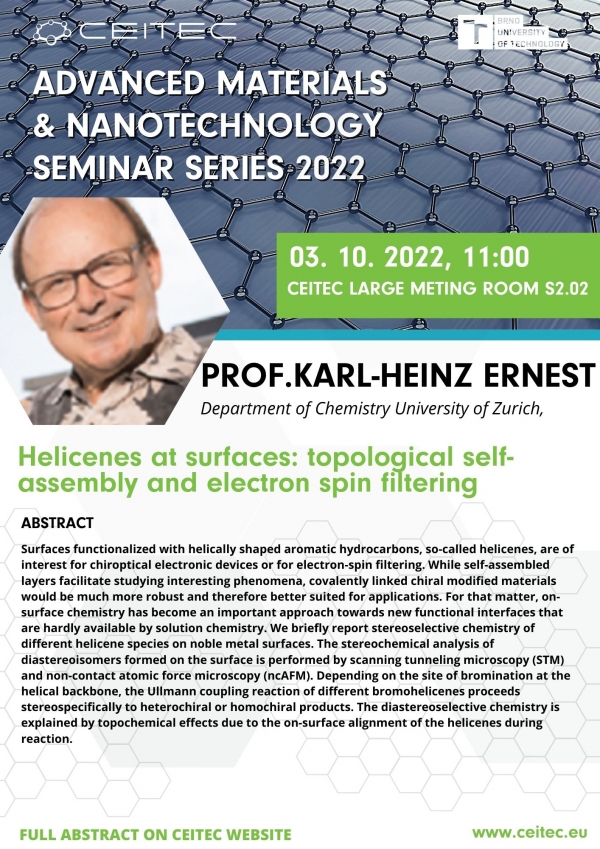About event
Surfaces functionalized with helically shaped aromatic hydrocarbons, so-called helicenes, are of interest for chiroptical electronic devices or for electron-spin filtering. While self-assembled layers facilitate studying interesting phenomena, covalently linked chiral modified materials would be much more robust and therefore better suited for applications. For that matter, on-surface chemistry has become an important approach towards new functional interfaces that are hardly available by solution chemistry. We briefly report stereoselective chemistry of different helicene species on noble metal surfaces. The stereochemical analysis of diastereoisomers formed on the surface is performed by scanning tunneling microscopy (STM) and non-contact atomic force microscopy (ncAFM). Depending on the site of bromination at the helical backbone, the Ullmann coupling reaction of different bromohelicenes proceeds stereospecifically to heterochiral or homochiral products. The diastereoselective chemistry is explained by topochemical effects due to the on-surface alignment of the helicenes during reaction.
Cyclodehydrogenation of sterically overcrowded precursor molecules into planar polycyclic aromatic hydrocarbons (PAH) is also an important step to all-carbon nanostructures, such as nanographenes. For example, graphene nanoribbons, carbon nanotubes and nanographenes have been synthesized after deposition of aromatic precursors followed by thermally induced C-C coupling and dehydrogenation. Here, surface alignment and two-dimensional packing of precursors, intra-molecular reactions can proceed highly stereospecifically. Bispentahelicene, for example, dehydrogenates thermally into planar, but still chiral entities, which aggregate into homochiral domains.
After an introduction on different aspects of two-dimensional self-assembly of chiral molecules in general and helicenes in particular, we report a unique trans-mission of chirality from single polyaromatic hydro-carbons into two-dimensional self-assembled mono-layers on a silver surface. The relatively high molecular flexibility of 1,3,5-tristetrahelicenebenzene allows adaptation of handedness during crystal growth which is governed rather by entropy than by enthalpy. The 2D crystal is a solid solution with domains of opposite enantiomeric excess and supramolecular handedness. The layer is dominated by motifs, such as nodes of different topology, i.e., two-armed and three-armed spirals, and by enantiospecific lateral offset of oligomeric triangles. To our knowledge such chiral self-assembly phenomenon has been neither reported previously nor has such aperiodic tiling of the plane been previously described by mathematical analysis.
Finally, we will report different studies performed with helicenes in order to shine light into the so-called chirality-induced spin selectivity (CISS) effect. Our experiments include different approaches, such as spin-selective analyses of photoelectrons with Mott and FERRUM detectors [1,2], spin-polarized low-energy electron microscopy (SP-LEEM) [3], and possible enantioselective interactions or different work function of helicenes on different out-of-plane magnetized domains of ferromagnetic substrates [3]. In part contradicting results of these experiments will be discussed.
References
[1] M. Escher, N. B. Weber, M. Merkel, L. Plucinski and C. M. Schneider, e-J. Surf. Sci. Nanotechn. 9, 340 (2011).
[2] M. Kettner, V. V. Maslyuk, D. Nürenberg, J. Seibel, R. Gutierrez, G. Cuniberti, K.-H. Ernst, H. Zacharias, J. Phys. Chem. Lett. 9, 2025 (2018).
[3] M. Baljozović, A. F. Cauduro, J. Seibel, A. Mairena, S. Grass, J. Lacour, A. Schmid and K.-H. Ernst, Phys. Status Solidi B 258, 2100263 (2021).




